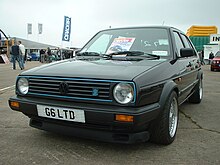| Volkswagen G60/G40 engine | |
|---|---|
| Overview | |
| Manufacturer | Volkswagen Group |
| Production | G60: August 1988–July 1993 G40: August 1986–July 1994 |
| Layout | |
| Configuration | Inline-4 |
| Displacement | G60: 1.8 L (1,781 cc) G40: 1.3 L (1,272 cc) |
| Cylinder bore | G60: 81 mm (3.19 in) G40: 75 mm (2.95 in) |
| Piston stroke | G60: 86.4 mm (3.40 in) G40: 72 mm (2.83 in) |
| Cylinder block material | Gray cast iron |
| Cylinder head material | Cast aluminium alloy |
| Valvetrain | 2 valves per cylinder, hydraulic valve lifters, belt-driven single overhead camshaft (SOHC) |
| Compression ratio | 8.0:1 |
| Combustion | |
| Supercharger | G-Lader with intercooler |
| Fuel system | Common rail electronic Multi-point fuel injection |
| Management | Bosch Digifant |
| Fuel type | Unleaded Gasoline |
| Oil system | Wet sump |
| Cooling system | Water-cooled |
| Output | |
| Power output | G60: 118 kW (160 PS; 158 bhp) G40: 85 kW (116 PS; 114 bhp) |
| Torque output | G60: 225 N⋅m (166 lb⋅ft) G40: 150 N⋅m (111 lb⋅ft) |
| Chronology | |
| Successor | 2005 1.4-litre 'Twincharger' |



The Volkswagen G60 and G40 were inline–four-cylinder automobile petrol engines, which used a specific method of forced induction by way of a scroll-type supercharger. The G60 engine was formerly manufactured by the German automaker Volkswagen Group and was installed in a limited number of their 'hot hatch' cars from their Volkswagen Passenger Cars marque from August 1988 to July 1993.[1]
A smaller G40 engine of identical design was previously installed in the Mk2 Volkswagen Polo GT G40 from August 1986 to July 1994.